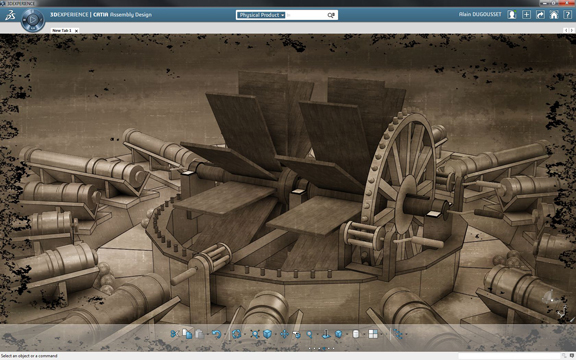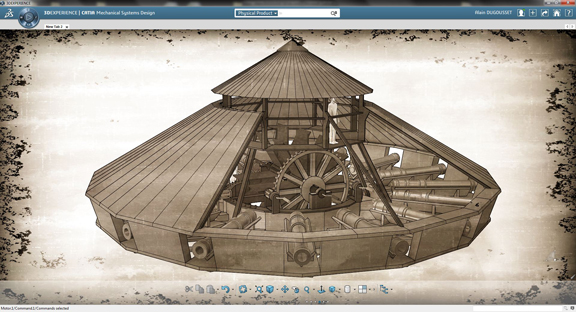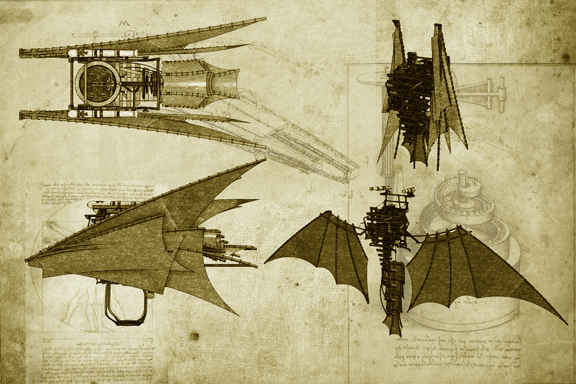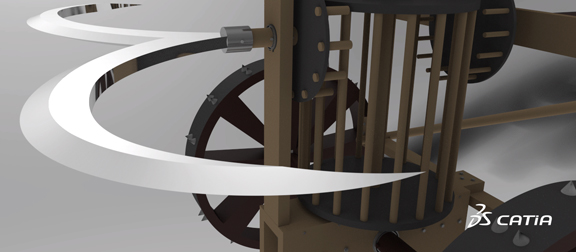Latest News
May 13, 2014
Leonardo Da Vinci, remembered for his artistic masterpiece Mona Lisa, also left behind quite a lot of engineering drawings that were never realized or tested. They’re preserved in his sketchbook, known as The Codex Arundel (now digitized and archived online at the British Library’s site). Many of his ideas—like his mechanical wings, flying ships, and war engines—would have required crews, carpenters, and craftsmen to properly prototype and test. Suppose he could travel in time and gain access to the type of 3D CAD programs designers and engineers use today for concept exploration, what might he have done with it? How would his ideas look as digital prototypes?
Alain Dugousset, Thibault Waltzer, and Antonio Perez have a pretty good idea. As participants and the top-three winners of the Da Vinci 3D 2014 contest (January-April 2014, sponsored by HP and AMD, organized by Dassault Systemes), they each chose a codex—a concept sketch of Da Vinci—and reproduced it in great details in 3D. They went so far as to test the assemblies and mechanism in animated sequences to see if their versions would operate without clashes and collisions.
Alain had spent time both in Paris and Firenze, where Da Vinci’s artworks were part of the cultural landscape. He reflected, “As a mechanical engineer, Da Vinci is a kind of master for me. Moreover, his capability to associate art and science is really amazing.” He knew most people have seen, and many have also attempted to recreate, famous pieces like the flying machine, the tank, and the automated car. So he went in search of a lesser known concept.
“Looking at the Piazza della Scala documents provided for the contest, I found a top view of a kind of military ship—I call it the Leonardo Battleship,” he recalled. ” It has two other sectional views, but “the third dimension of this machine seems to be missing,” he said.
To solve this problem, Alain had to take some artistic liberties. “I decided to merge these drawings with the one for a tank to create the third dimension,” he said. In doing so, he faced a new issue. “Driving a tank is something simple, but what about a cylindrical ship?” Without any helm visible in the original drawings, he was left to press his imagination into service.
Alain recounted, “My first idea was to work on the two main gears inside the ship, which can be seen on the most detailed drawing. It seems there’s a starting wheel only on one side, but it seems to me it’s impossible to have the ship maneuvered by two separate gears with two different speeds. In fact, if those two gears are not linked together, during the starting operation, the ship will not go forward ... That why I have developed another mechanism to maneuver the ship, using other information visible on Da Vinci’s drawings.”
Alain used Dassault’s 3DEXPERIENCE platform (CATIA is part of it) to create his digital mockup of the Leonardo Battleship. The virtual environment—the 3D landscape that makes up the backdrop in his presentation video—was sculpted in 3DVIA Studio. For comparison and perspective, he went ahead and included another ship, a virtual model of the BB-62 New Jersey.
Thibault said, “I chose the flying machine because it is the most famous machine of Da Vinci and it’s a nice challenge to revisit. I wanted to design something totally different from Da Vinci’s models, but also pay tribute to Da Vinci with a complex mechanical model. As I like the wing-suit, I created a Da Vinci’s-style plane pack.”
Thibault used Dassault’s CATIA to design the shape and kinematics of the system. As he wanted to adhere to the mechanical practices available during the Renaissance for authenticity, he said, “The biggest challenge was to create a complex, functional mechanism while respecting the technology and the materials of Da Vinci’s time.”
Antonio said, “I was very impressed with the concept of the scythe chariot and its transmission design.” He remarked, “It’s a war machine used for ground combat. It combines the concept of a conventional war chariot and the scythe blades that are very effective in rotational motion.”
Antonio used Dassault’s CATIA to model, simulate, and render his design. Unlike in a contemporary engineering project, Da Vinci’s blueprint for the idea didn’t come with dimensions or measurements. So Antonio said “I had to guess the dimensions of every part, which took several iterations be accurate.”
The size and scale of the battleship is too ambitious for Alain to translate into a physical prototype, so today he has to be satisfied with a 3D-printed scale model.
Thibault may have to do some additional work before he can 3D-print his winged plane pack. “The complexity and the size of my different parts aren’t compatible with the 3D-printing technology,” he said. “So I think the biggest challenge to print my model are the different conductivities and the strength of materials.”
Antonio, too, is looking into 3D-printing his model in a smaller scale. A full scale version, he suspects, would be difficult to assemble, as “There are around 60 parts that need to be glued, bolted, or fastened,” he said.
For more, watch the video below, produced by the contest organizers.
Subscribe to our FREE magazine, FREE email newsletters or both!
Latest News
About the Author
Kenneth Wong is Digital Engineering’s resident blogger and senior editor. Email him at [email protected] or share your thoughts on this article at digitaleng.news/facebook.
Follow DE









